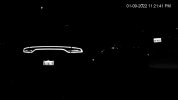To the OP, keep in mind that if you use a PTZ for LPR, except in a few ideal situations, you have to basically turn the PTZ into a "fixed" camera and not move it around or track at night.
Unlike fixed cameras, the PTZ does not have a manual focus number you can dial up.
As you can see from the example above and mine below, most of us only get the head/tail lights and the plate at night, so the PTZ has to be set and focused while still enough light out or it will not be in focus when the camera moves back to the spot for plates.
Keep in mind that this is a
camera dedicated to plates and not an overview camera also. It is as much an art as it is a science.
You will need two cameras. For LPR we need to OPTICALLY zoom in tight to make the plate as large as possible. For most of us, all you see is the not much more than a vehicle in the entire frame. Now maybe in the right location during the day it might be able to see some other things, but not at night.
At night, we have to run a very fast shutter speed (1/2,000) and in B/W with IR and the image will be black. All you will see are head/tail lights and the plate. Some people can get away with color if they have enough street lights, but most of us cannot. Here is a representative sample of plates I get at night of vehicles traveling about 45MPH at 175 feet from my 2MP 5241-Z12E camera (that is all that is needed for plates):
See the
LPR subforum for more details.


